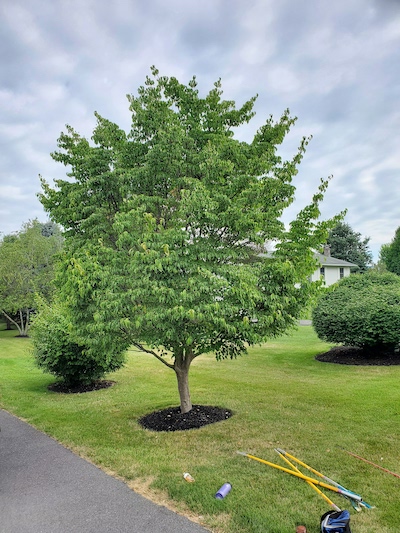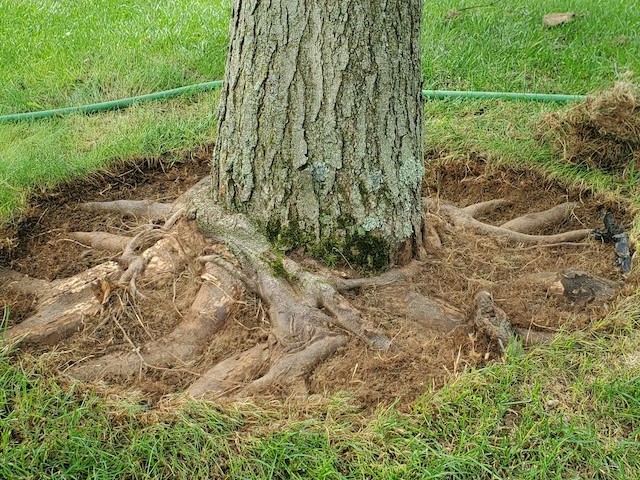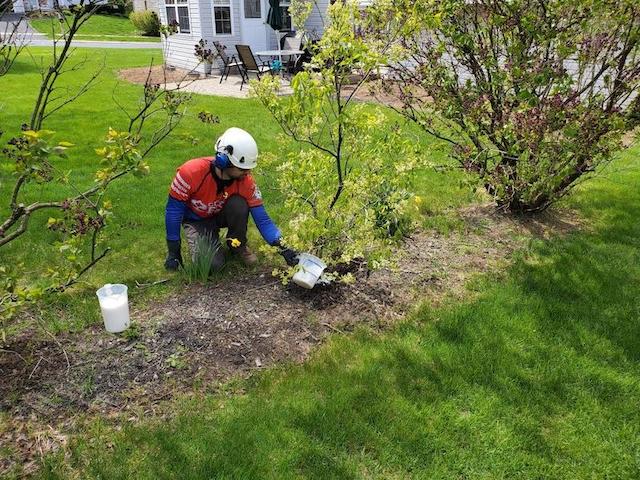Tree Preservation: Ensuring a Healthy Landscape
Trees and shrubs play a critical role in our ecosystem, not only by providing us with clean air and shade but also by creating a comfortable and beautiful landscape. However, maintaining a healthy landscape can be challenging, especially when dealing with the effects of urbanization.
At Cutting Edge Tree Professionals we understand the importance of tree preservation in landscaping, address the challenges faced by trees and shrubs in planned landscapes, and provide tips on how to ensure their healthy growth. We will also cover the impact of construction activities on trees and shrubs and share best practices for tree preservation in landscaping. So, whether you’re an avid gardener or just someone who loves being surrounded by greenery, read on to learn more about the vital role trees play in our lives!

What are the benefits of preserving trees?
Preserving trees provides numerous benefits, including improved air quality, reduced energy costs, increased property value, and enhanced biodiversity. Trees also help prevent soil erosion, provide shade and habitat for wildlife, and contribute to overall physical and mental well-being.
Cutting Edge Tree Preservation Services

Tree Health Care
Unlock a healthier, greener future with our comprehensive tree health care services, where we don’t just care for trees, we nurture life and enhance environments

Tree Fertilization
Ensure your trees reach their full potential with our tree fertilization services, designed to supplement, rejuvenate, strengthen, and enhance the vitality of your green spaces

Pest Control
Safeguard your cherished trees from harmful invaders with our expert tree pest control services, providing a robust defense that not only protects, but rejuvenates your greenspace
The Difference between the Forest and Landscapes
Forestry and landscape are fundamentally distinct in terms of their composition and management. While forests are natural ecosystems relying on natural processes for growth and maintenance, landscapes are heavily influenced by human intervention and management. When it comes to tree preservation in landscapes, careful planning and management are crucial for maintaining a healthy and sustainable environment. Factors such as soil quality, water availability, and proper pruning techniques must all be considered. The preservation of trees not only enhances the aesthetics but also provides various benefits such as improved air quality, wildlife habitat, and increased property value. Collaboration between homeowners, landscapers, and arborists is essential for successful tree preservation in landscapes.
When a Tree or Shrub Succumbs to Disease or Insect Infestation in the Forest
When a tree or shrub succumbs to disease or insect infestation in the forest, it plays a vital role in the ecosystem’s natural cycle. These diseased or infested trees are left to decompose naturally, providing valuable nutrients to the surrounding environment. However, in a landscape setting, it is essential to remove these trees to prevent the spread of the problem to other plants. Timing is critical in both scenarios, as prompt action can help prevent further damage. To maintain a healthy landscape, prevention is key. This includes proper maintenance practices and early detection of any issues. Professional arborists can diagnose and treat diseases and infestations, helping to preserve the health of trees and shrubs in landscapes.
A Tree and Shrub’s proportional fit in Landscaping
When incorporating trees and shrubs into a landscape, it is essential to consider their proportionate fit with the overall size of the area. The impact of replacing a large tree with a small tree can dramatically change the appeal of the landscape. A harmonious blend of plant life not only enhances the beauty of the landscape but also contributes to its functionality. Proper spacing between plantings allows for healthy growth and maintenance. Trees and shrubs play a crucial role in providing shade, creating wildlife habitats, and improving air quality. To ensure their longevity, it is important to provide proper care, pruning, and maintenance. This preventive approach is more cost-effective than replacing mature trees or shrubs with ones of similar size.
The Importance of Tree Preservation in Landscaping
Preserving the natural beauty of your landscape is not only visually appealing but also essential for the overall health of your property. Trees play a crucial role in enhancing the aesthetics and ecological balance of your landscape. By providing shade, improving air quality, and reducing soil erosion, trees contribute significantly to creating a sustainable and environmentally friendly environment. Additionally, proper tree care increases property values and attracts wildlife, adding to the overall appeal of your landscape. Tree preservation should be a priority for any homeowner or landscaper looking to create a healthy and thriving outdoor space.The Role of Trees and Shrubs in a Meticulously Designed Ecosystem
Trees and shrubs play a vital role in meticulously designed ecosystems, providing numerous benefits for both the environment and our well-being. These woody plants offer shade, oxygen, and essential habitats for wildlife. Additionally, they help prevent soil erosion and filter pollutants from the air and water, improving overall environmental quality. To maintain a healthy landscape, it is crucial to care for and maintain trees and shrubs properly. Regular pruning, watering, and fertilization can promote their health and resilience against diseases and pests. Moreover, when planning your landscape, selecting tree and shrub species that are well-suited to the local environment ensures long-term sustainability.Understanding the Challenges Faced by Trees and Shrubs in Planned Landscapes
Excessive foot traffic, construction activities, and heavy machinery can compact the soil in planned landscapes, restricting air and water supply to roots. Improper grading and drainage systems can lead to poor drainage, resulting in waterlogging and root rot. Planned landscapes often have limited soil space, requiring supplemental fertilization and soil amendments to provide the necessary nutrients for healthy trees and shrubs. Additionally, pests like insects and diseases caused by fungi and bacteria pose threats to their well-being. Improper pruning, overwatering, and chemical exposure can also harm trees and shrubs. Ensuring their health and longevity requires understanding and addressing these challenges.
Disease and Insect Infestations
Spread of diseases and insect infestations pose a significant threat to the health and vitality of trees and shrubs in planned landscapes. To safeguard against these potential risks, it is essential to focus on prevention through proper maintenance, pruning, and sanitation practices. By regularly inspecting for signs of disease or infestation, you can detect and intervene early, minimizing their impact. It’s worth noting that certain species of trees and shrubs are more susceptible to specific diseases and insects than others, so being aware of these vulnerabilities can inform your preventive measures. In some cases, seeking professional help from one of our arborists may lead to a quick preventive strategy to ensure the overall health of your landscape.
Maintaining Aesthetic Balance & Overall Health of Landscape
To maintain the aesthetic balance and overall health of your landscape, it’s crucial to select trees and shrubs that are adaptable to your local environmental conditions. Regular pruning and maintenance practices not only enhance the visual appeal of your landscape but also promote the health of your trees. Remember to water your trees and shrubs regularly, providing them with the right amount of moisture for their survival. Fertilizing them with the appropriate nutrients ensures their long-term health. Fully understanding pounds of nitrogen, square feet of surface area, rainfall and runoff are just some of the considerations our Arborists pay attention to. Proactive pest control measures should also be implemented to prevent any potential damage to your trees and shrubs. By following these practices, you can maintain the beauty and vitality of your landscape.
How to Ensure Healthy Growth of Trees in Landscapes
Regular health checks and preventive measures are crucial for maintaining the well-being of trees in landscapes, but its much more than just applying the right amount of fertilizer. By conducting regular soil tests, you can determine the specific nutrient requirements of your trees and adjust fertilizer usage accordingly. Proper watering techniques, such as maintaining soil moisture levels and avoiding drought stress, are vital for promoting healthy growth. Protecting the root zone and soil surface of trees helps maintain optimal health by preventing damage and improving soil structure. Additionally, pruning and mulching can promote tree structure and retain soil moisture. By following these practices, you can ensure the healthy growth of trees in your landscape.
Regular Health Checks and Preventive Measures
Regularly inspecting trees for signs of disease, insect infestation, and structural issues is crucial for ensuring their long-term health. It’s also important to monitor tree growth, root growth, health, and canopy structure on a regular basis. Implementing preventive measures, such as tree injections and root fertilization, can greatly contribute to the overall health of the trees. Consulting with arborists for regular tree care, health checks, and treatment plans is highly recommended. Our certified arborists will not always suggest herbicides and pesticides to solve a problem. Additionally, practicing proper irrigation and mulching techniques can help prevent tree stress and disease. By taking these preventive measures, you can ensure that your trees remain healthy and vibrant for years to come.
Appropriate Soil and Fertilizer Usage
To ensure the health and vitality of trees, it is important to assess soil conditions and test for nutrient deficiencies as well as pH levels. By applying organic matter and essential nutrients like nitrogen and phosphorus, we can promote the overall well-being of trees. It is crucial to use complete fertilizers and apply the proper amounts based on the specific needs of both the tree and the soil. Additional fertilizer applications may be necessary for young trees and those growing in poor soil conditions. For personalized soil testing and fertilizer recommendations, it’s advisable to consult arborists who specialize in tree health.
The Impact of Construction Activities on Trees and Shrubs
Construction activities have the potential to cause significant damage to trees and shrubs, leading to their decline or even death. To ensure the preservation of these vital natural resources, it is crucial to develop tree preservation plans before construction begins. These plans include techniques like root pruning and tree relocation, which can effectively protect trees during construction. However, the preservation efforts should not end there. It is equally important to monitor the trees after construction for any signs of stress or damage. By preserving trees, we not only enhance the beauty and value of our properties but also reap environmental benefits such as shade provision and improved air quality.
Tips for Minimizing Construction-Related Damage
During construction planning and design, it is crucial to prioritize the protection of trees. One effective measure is the use of barriers and fencing to shield trees from construction activities. It is also important to minimize soil compaction around trees and avoid damaging their root systems. Prior to and after construction, proper pruning can promote tree recovery. To ensure the health of trees during and after construction, consider hiring an arborist for assessment and management. By implementing these tips, you can minimize construction-related damage and preserve the beauty and value of your landscape.
What are the Best Practices for Tree Preservation in Landscaping?
Proper fertilization and soil care are vital for maintaining the health of trees and shrubs in landscaping.
Regular disease prevention and treatment, along with effective insect control, are crucial for preserving a healthy landscape.
Conducting soil testing, adjusting soil conditions along with minor nutrients, mulching, and providing adequate watering further support tree and shrub growth.
Preserving trees in landscapes is vital for maintaining a healthy and aesthetic environment. Trees play a crucial role in providing shade, improving air quality, and creating a balanced ecosystem.
Protecting them from disease, insect infestations, and construction-related damage is essential.
Regular health checks, preventive measures, and appropriate soil and fertilizer usage contribute to their healthy growth. Additionally, minimizing construction-related damage through careful planning and implementation is crucial.
By following these best practices, you can ensure the long-term health and beauty of your landscape.
Remember, trees are not just decorative elements; they are living organisms that require care and preservation.
So let’s come together to create and maintain a vibrant and sustainable landscape for generations to come.
